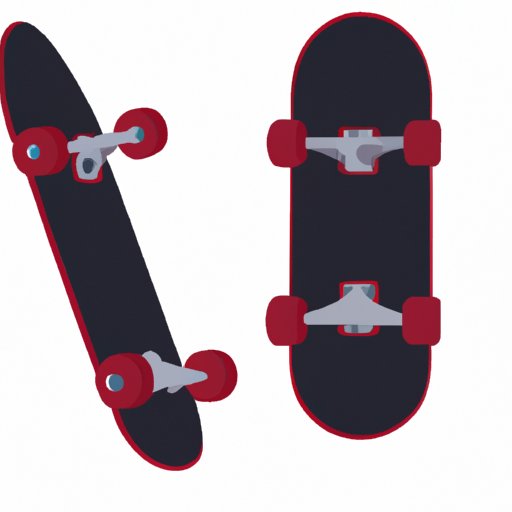I. Introduction
Skateboarding has come a long way from being just a recreational activity for teenagers. These days it’s recognized as a skill-based sport that requires balance, coordination, and agility. Not only does it improve your physical fitness, but also provides mental health benefits such as better concentration and a sense of accomplishment. With the rise in popularity of skateboarding as a sport, many people are wondering if it’s an effective workout. This article explores the various benefits of skateboarding as exercise, and whether it can replace traditional forms of exercise.

II. 7 Reasons Why Skateboarding is a Great Workout
Skateboarding is a unique form of exercise that engages different muscle groups and improves cardiovascular health. Here are seven reasons why skateboarding is a great workout:
1. Works All Major Muscle Groups
Skateboarding is a full-body workout that engages all major muscle groups. When you’re skateboarding, you’re constantly pushing off the ground, maintaining balance, and making turns. These actions activate your legs, core, and back muscles. Moreover, skateboarding requires arm and shoulder strength to maintain balance which means you’re challenging your upper body as well.
2. Boosts Cardiovascular Health
Skateboarding is a low-impact form of cardio that can elevate your heart rate and increase your endurance. If you are looking for a workout that can get your heart rate up, skateboarding can be an excellent alternative to running or cycling. It might not burn the same number of calories as a high-intensity workout, but it can still help improve your cardiovascular fitness.
3. Improves Balance and Coordination
To successfully skateboard, you need to have excellent balance and coordination. The physical demands of skateboarding require you to maintain stability while in motion, which uses your entire body to stabilize and coordinate movements. Over time, this can lead to improved proprioception, which is your body’s ability to sense its own position in space. Having better proprioception is useful for everyday life and can also help prevent falls in older individuals.
4. Increases Flexibility
Skateboarding requires a lot of movement at the ankles, which helps promote flexibility in lower body muscles. More specifically, when you perform tricks such as Ollies and kickflips, you are engaging your legs in various movements that increase mobility in the hips, hamstrings, calves, and ankle joints. Therefore, incorporating skateboarding into your exercise regimen can help improve your overall flexibility.
5. Builds Endurance
Skateboarding requires a combination of both short bursts of energy and long-distance activities. As you push yourself to skateboard for longer periods, you will build up your endurance levels. Over time, this endurance will improve your body’s ability to handle long-distance activities, such as running or hiking.
6. Engages Mental Focus
Skateboarding is not only physically challenging, but it also requires a lot of mental focus. When you are trying to master a new trick or navigate through an obstacle course, you need to be completely focused on the task at hand. This constant mental challenge can improve your concentration and focus, which can help you in other tasks as well.
7. Provides a Unique Sense of Accomplishment
Skateboarding gives you a sense of accomplishment that is unique to the sport. The feeling of landing a new trick or completing a rough line is unmatched. Through skateboarding, you develop a sense of self-confidence and pride that comes from mastering something that is difficult.
III. Skateboarding vs. Traditional Exercise: Which is Better?
While skateboarding is a great workout, you might be wondering how it compares to traditional forms of exercise like running, weightlifting, or swimming. Here are some points to consider:
Time Efficiency
Skateboarding is generally a shorter workout and better suited for people who are time-strapped. You can skateboard for as little as 30 minutes a day and enjoy the benefits of a full-body workout.
Enjoyment and Motivation
Skateboarding is fun, and that means you are more likely to stick with it in the long run. When you enjoy what you’re doing, it’s easier to stay motivated to keep going. Traditional forms of exercise can often feel monotonous and dull, which can lead to lack of interest and motivation.
Complimentary to Other Workouts
While skateboarding can work as a full-body workout, it cannot replace traditional exercises completely. Incorporating skateboarding into your routine will provide an excellent cardio workout, but it’s always a good idea to also target particular muscle groups through weightlifting or bodyweight exercises.
Can be more Dangerous
Like any extreme sport, skateboarding comes with inherent risks such as the potential for falls, broken bones, and serious injuries. While traditional exercise has some risks, injuries are generally less severe. Additionally, you may need safety gear such as helmets, elbow, and knee pads to reduce the risk of injuries.
IV. Expert Interview: A Personal Trainer’s Perspective on Skateboarding as a Workout
To provide more insight into skateboarding as a workout, we interviewed Clara who is a personal trainer and also teaches skateboarding to clients. Following are her thoughts on skateboarding and how it can improve fitness:
Q: What are some benefits of skateboarding as exercise?
Clara: Skateboarding is an excellent workout that engages multiple muscle groups, especially your legs and core. It flexes your ankles and knees, which strengthens your joints and increases your body’s stability.
Q: Is skateboarding suitable for people of all ages?
Clara: Skateboarding is a versatile form of workout and can be done at any age, granted that the individual is physically fit to avoid risks and potential injuries associated with it. However, for those who are unprepared to start, I recommend starting with balance training on a balance board or wobble board to work up to the demands of skateboarding.
Q: Are there any precautions one should take when starting skateboarding?
Clara: Yes, I always advise my clients to wear safety gear such as helmets, knee pads, and elbow pads. You should also start on level ground, to avoid uneven terrain, and begin with simple tricks to lessen the chance of injury as you progress.

V. Personal Narrative: How Skateboarding Helped Me Get in Shape
Learning how to skateboard changed my life. I was gripped by the unique challenges and thrill of the sport. Skateboarding, while enjoyable, can also be highly daunting, but the feeling of elation you get when you land your first trick is something you’ll never forget.
When I first started, I had multiple wipeouts and struggled even to develop a sense of balance. But as my skills improved, I realized how much I was challenging my body and mind. As someone who struggles with anxiety, skateboarding provided a distraction from my worrying thoughts, and the fluid movements of the sport were soothing and calming.
Skateboarding not only helped me improve my physical health but also my mental health. It gave me a new hobby to focus on, a sense of fun accomplishment, and most of all, self-confidence.
VI. Research-based: The Science behind Skateboarding as a Beneficial Exercise
Skateboarding has caught the attention of many researchers, and several studies have investigated its physical and mental health benefits. Many findings suggest that skateboarding is an excellent way to improve your health.
One study showed that skateboarding can have similar cardiovascular benefits as traditional forms of exercise. Skateboarding can elevate your heart rate and increase your endurance levels, just as running or cycling can. The study found that skateboarding also helped improve balance and coordination, which contributed to better proprioception and fall prevention in older adults.
Additionally, another study found that skateboarding can lead to improved mental health. Skateboarding is challenging and requires a considerable amount of mental focus, this challenge can stimulate feel-good chemicals in the brain, such as endorphins, which can improve your mood.
VII. Comparison: How Skateboarding Compares to Other Extreme Sports in Terms of Fitness Benefits
Skateboarding is just one of many extreme sports that provide a great workout. To compare skateboarding to other extreme sports, let’s look at surfing, snowboarding, and BMX biking.
Surfing
Surfing is an intense workout that engages your entire body. It’s different from skateboarding as it requires you to use more leg muscles to push yourself while riding the waves, but it still provides similar cardiovascular benefits and improves your balance and coordination.
Snowboarding
Snowboarding is a high-intensity workout that engages your legs, core, and shoulders, much like skateboarding. However, it is much more dangerous, requiring a lot of safety gear such as helmets and specialized snow boots. Because of this, it might not be the most practical choice, especially for those who live in an area without snow.
BMX Biking
BMX biking shares many similarities with skateboarding, such as working the same muscle groups, developing balance, coordination, and endurance. However, unlike skateboarding, which can be done anywhere, BMX biking requires specialized tracks and facilities, which can be off-putting for some people.
VIII. Conclusion
Skateboarding is an excellent workout that provides unique physical and mental health benefits. With its emphasis on balance, coordination, and motor control, skateboarding can complement other forms of exercise and engage muscle groups that traditional exercises might not work. However, as with any sport, there are risks involved, and it’s essential to wear safety gear and take precautions to avoid injuries.
If you’re looking for a workout that is engaging and fun, then skateboarding might be the sport for you. Not only will you get a good workout, but also you will develop a sense of self-confidence and pride that comes from mastering something that is challenging.
